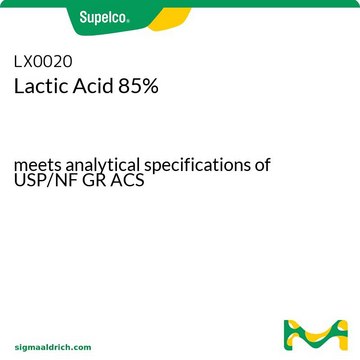L6661
Lactic acid
meets USP testing specifications
Synonyme(s) :
DL-Lactic acid, 2-Hydroxypropionic acid
About This Item
Produits recommandés
Agence
USP/NF
meets USP testing specifications
Niveau de qualité
Essai
88.0-92.0%
Forme
viscous liquid
Indice de réfraction
n20/D 1.425 (lit.)
pH
2
pb
122 °C/15 mmHg (lit.)
Densité
1.209 g/mL at 25 °C (lit.)
Traces de cations
heavy metals: ≤0.001%
Application(s)
pharmaceutical (small molecule)
Température de stockage
room temp
Chaîne SMILES
CC(O)C(O)=O
InChI
1S/C3H6O3/c1-2(4)3(5)6/h2,4H,1H3,(H,5,6)
Clé InChI
JVTAAEKCZFNVCJ-UHFFFAOYSA-N
Vous recherchez des produits similaires ? Visite Guide de comparaison des produits
Catégories apparentées
Actions biochimiques/physiologiques
Autres remarques
Mention d'avertissement
Danger
Mentions de danger
Classification des risques
Eye Dam. 1 - Skin Corr. 1C
Risques supp
Code de la classe de stockage
8A - Combustible corrosive hazardous materials
Classe de danger pour l'eau (WGK)
WGK 1
Point d'éclair (°F)
235.4 °F - closed cup
Point d'éclair (°C)
113 °C - closed cup
Équipement de protection individuelle
Eyeshields, Gloves, type ABEK (EN14387) respirator filter
Faites votre choix parmi les versions les plus récentes :
Déjà en possession de ce produit ?
Retrouvez la documentation relative aux produits que vous avez récemment achetés dans la Bibliothèque de documents.
Les clients ont également consulté
Protocoles
Separation of DL-Lactic acid, ~90% (T)
Separation of Pyruvic acid, United States Pharmacopeia (USP) Reference Standard; Tartaric acid, United States Pharmacopeia (USP) Reference Standard; Citric acid, United States Pharmacopeia (USP) Reference Standard; Malic acid, United States Pharmacopeia (USP) Reference Standard; L-Pyroglutamic acid, ≥99.0% (T); Lactic acid, United States Pharmacopeia (USP) Reference Standard; Acetic acid, ≥99.99% trace metals basis; Succinic acid, United States Pharmacopeia (USP) Reference Standard
Chromatograms
application for HPLCapplication for HPLCNotre équipe de scientifiques dispose d'une expérience dans tous les secteurs de la recherche, notamment en sciences de la vie, science des matériaux, synthèse chimique, chromatographie, analyse et dans de nombreux autres domaines..
Contacter notre Service technique



